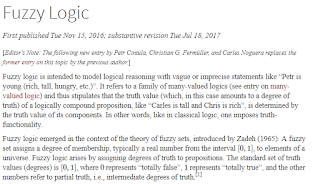 |
| Stanford Encyclopedia of Philosophy |
Stanford Encyclopedia of Philosophy
Premises and conclusions using fuzzy logic would be philosophically imprecise.
This type of logic was something I was strictly guided not to present when writing my British academic questionnaires.
But even with British academic propositions, it was difficult to avoid degrees of truth. When dealing with the problem of evil and theodicy, I was often faced with concepts of degrees of evil. My doctoral text was reviewing and countering the philosophy that gratuitous evil worked against the existence of God. There are often, I reason, degrees of evil, but in my Reformed theology and philosophy I embraced the view that God wills and causes all things (both directly and allowing) and uses evil for divine purposes, and in that sense it is not gratuitous evil.
However, in my view, presenting logical and more importantly to me, reasonable premises and conclusions in text does at times require the use of degrees of truth.
For example, the use of HTML colour requires degrees and shades of red. A bright red, solid form of red is represented as #FF0000 from many sources. Another form of red may be called red, but is actually brownish in colour, for example. Various degrees and shades can be presented logically and reasonably with premises and conclusions, but in reality, there are many kinds of reds. Some are mixed with blue and/or yellow and other colours.
 |
| Blackburn page 151. |
From Blackburn, again as with the Langer, Symbolic Logic textbook, we deal with negation. If a room is hot, using fuzzy logic and logic of degrees, then it is at the same time, not cold.
BLACKBURN, SIMON (1996) Oxford Dictionary of Philosophy, Oxford, Oxford University Press.
 |
| Blackburn |